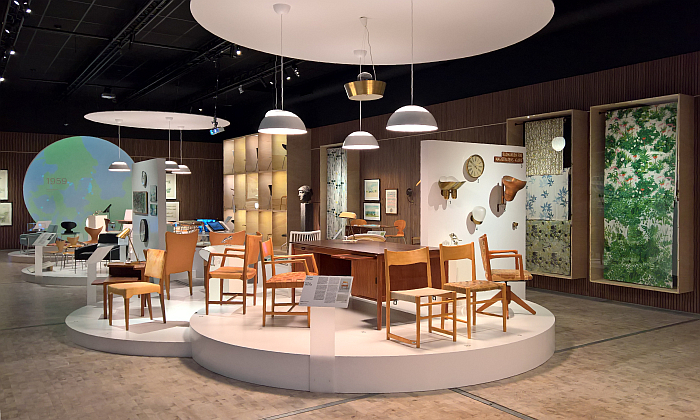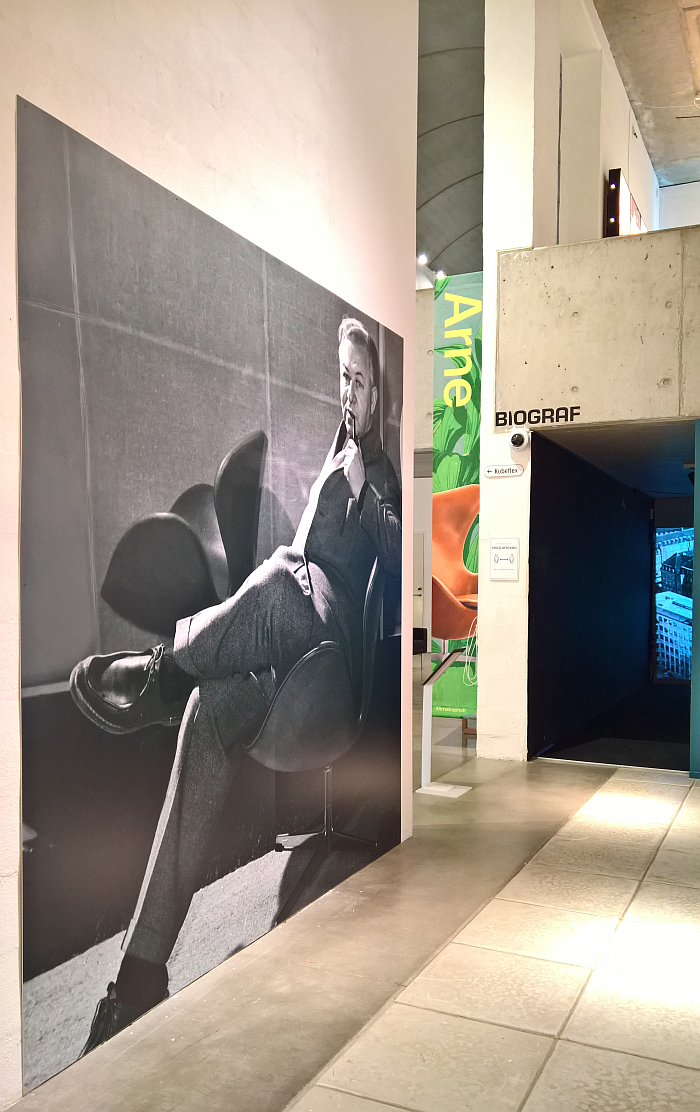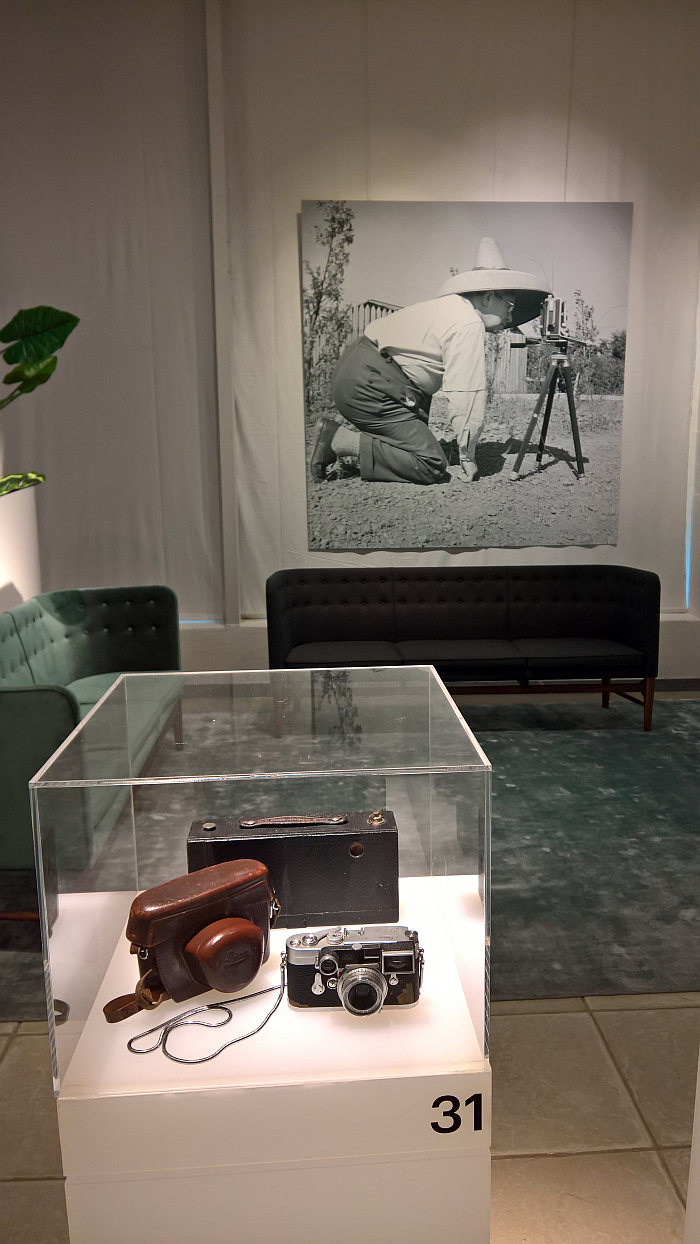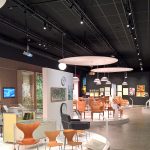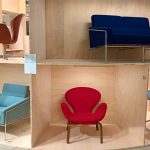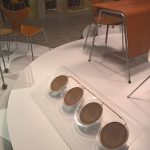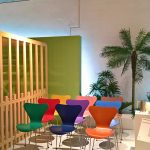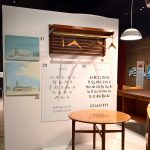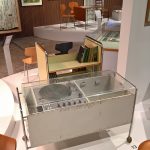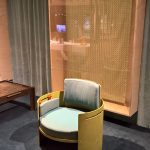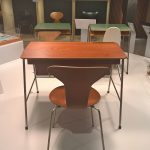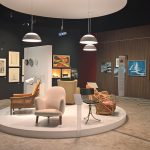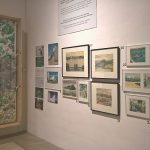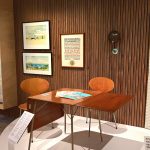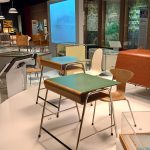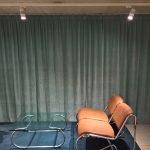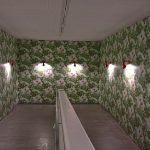Arne Jacobsen – Designing Denmark at Trapholt, Kolding
“Hvis jeg får et nyt liv, vil jeg være gartner“, opined once the Danish architect and designer Arne Jacobsen.
“If I have another life, I want to be a gardener”
Not that, as Arne Jacobsen – Designing Denmark at Trapholt, Kolding, would tend to imply, he made an incorrect career choice…..
Arne Emile Jacobsen was born in Copenhagen on February 11th 1902 into a, by all accounts, comfortable middle class family; his mother a trained bank clerk, and that as the first female in Denmark to complete such a training, his father a wholesaler of safety pins, snap fasteners and similar small metal objects of necessity for the clothing retail industry. That we’ve (briefly) discussed Arne Jacobsen’s biography in a previous post, we refer you there dear reader for the key dates, and begin here in Trapholt in the opening chapter of Arne Jacobsen – Designing Denmark, a chapter which greets you with the question Er det dansk?, Is it Danish design? A question we’ll come back to, and a chapter that is the principle delight and joy of the exhibition.
Not that the other chapters aren’t interesting, informative and entertaining, SPOILER ALERT, they are, but they are also chapters (largely) populated by the familiar objects and accoutrements of the Arne Jacobsen biography; the opening chapter contains those less often discussed and certainly less often exhibited, but every bit as crucial projects and objects. Arguably the more crucial projects and objects.
Or put another way, the popular biography of Arne Jacobsen begins in 1952 with his Ant chair.
Arne Jacobsen was born on February 11th 1902.
When the Ant was formally launched in October 1952, Arne Jacobsen was 50. Approaching 51.
And with, as the first chapter of Designing Denmark elegantly explains, a long, varied and not unimportant career behind him.
A long and varied career that, in many regards, began with, and was for its entire duration influenced and informed by, a passion, and talent for, painting; a passion and talent that he, possibly, inherited from his mother, but that more certainly his father wasn’t keen that he follow professionally, and so the young Arne opted for gardening architecture, a profession that in the early decades of the 20th century was still very closely associated with art. Was still (largely) one of artists, of painters. And thus one which offered him the opportunity to remain close to painting. And a profession he entered via foundation courses in building and construction at the local technical college, augmented with summers spent as a stonemason’s apprentice, before in 1924 he enrolled in the architecture department of Copenhagen’s Kongelige Danske Kunstakademi where, and for all during study trips to France and Italy, Jacobsen became not only acquainted with, but partial to, classical architecture. A partiality, arguably, reflected in his 1927 graduation project: a museum building with a pronounced neoclassicist, and slightly national romantic?, accent.
However, and very much as with an Alvar Aalto, alongside classical understandings the young Arne Jacobsen was increasingly exposed throughout the 1920s to more contemporary understandings of and positions to architecture and design, for all through moments such as the 1925 L’Exposition internationale des arts décoratifs et industriels modernes in Paris where Arne Jacobsen (in all probability) assisted Kay Fisker on the Danish pavilion, an uncompromisingly quadratic work in brick; an event Jacobsen visited on a college trip and where the students were “warned not to be impressed by the modern bluff”1, a warning Jacobsen clearly didn’t heed; and where Arne Jacobsen won a silver medal for a, sadly long lost, chair design. In addition Germany, and for all projects such as the Neues Frankfurt estates or the Weissenhofsiedlung building exhibition in Stuttgart, provided cause and impetus for Jacobsen to think a fresh about architecture and design.
And thus, and again much like an Alvar Aalto, the late 1920s saw a marked shift in Jacobsen’s positions and understandings, a shift that made itself discernable and tangible in the first two projects one meets in Designing Denmark: the House of the Future and Bellevue Strandbad.
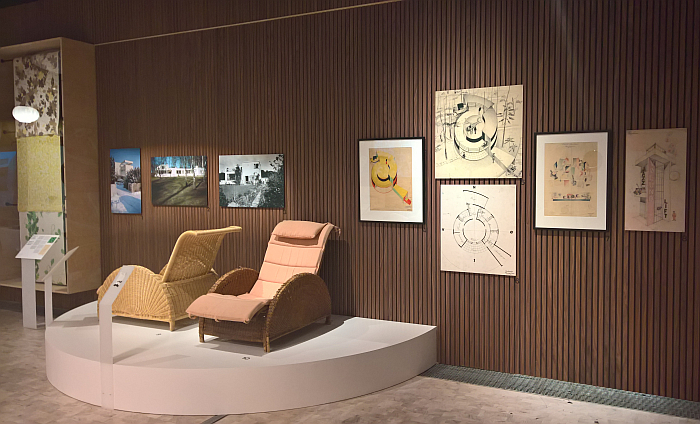
A presentation of the 1929 House of the Future including the Forest Snail chair by Arne Jacobsen, as seen at Arne Jacobsen – Designing Denmark, Trapholt, Kolding
The former, a project developed with his childhood friend Flemming Lassen in context of the 1929 Danish Architect’s Housing and Construction exhibition, a house very much of the future, as in a work of pure, unbridled fantasy, which isn’t a complaint, far from it; a house furnished with a mix of steel tube cantilever chairs by Mies van der Rohe and Lilly Reich and by rattan lounge chairs by Jacobsen, the so-called Forest Snail chair, chairs whose rolls and curves not only compliment the spiral of the house, but whose unequivocal solidarity with Art Déco stands as an outright challenge to the quadratic and linear of inter-War International Modernism; and a house which not only in its unashamed, decadent fancifulness, but also, arguably, its elegant, easy, humane, spiralling, formal expression meant that it was, by all accounts, the media hit of Denmark in 1929, would have been all over Instagram, and thereby helped establish the names of Lassen and Jacobsen.
And, arguably helped Arne Jacobsen win the 1930 competition for the Bellevue Strandbad in Klampenborg on the northern edges of Copenhagen. As previously discussed in these dispatches, Bellevue was Jacobsen’s first large scale commercial project; a project which saw the modernist inclined landscape architect C.Th. Sørensen develop a park next to the beach, while Jacobsen developed the changing rooms, kiosks, and associated buildings: a project which although it features quadratic white buildings of the International Modernist stylee, also features lifeguard towers with an ice cream sundae playfulness and which once visually complemented the actual ice cream kiosks, but sadly doesn’t feature a large observation tower with revolving UFO-esque restaurant, that was too modern, too futuristic, too tall, for the local planners; a project subsequently expanded to include a housing estate and a theatre; a project which although no longer fully extant is well worth a visit if you are in Copenhagen. And a project represented in Designing Denmark by furniture, photos and for all a film which helps underscore just how popular the Bellevue Strandbad was in the 1930s. A popularity that couldn’t help but rub off on the, barely 30 year old, Arne Jacobsen.
From those early projects Arne Jacobsen’s career moved over, and Designing Denmark moves over, projects such as, and amongst others, his first cooperations with Novo pharmaceuticals, who were to become an important client and component of the Jacobsen biography; Aarhus town hall, a project realised with Erik Møller, a young Hans J. Wegner serving as assistant; Rødovre town hall on the south-western edge of Copenhagen; or the Munkegård school in Gentofte, on the north-eastern edge.
And a progression that as presented and discussed in Designing Denmark helps underscore the central role of the Gesamtkunstwerk not only in and to the Jacobsen biography but in and to Jacobsen’s understandings of architecture and design. That from Bellevue onwards Arne Jacobsen not only realised architecture projects but designed the fixtures and fittings within, and for all designed the furniture within. And thus, and as Designing Denmark elegantly underscores, while not all of Arne Jacobsen’s furniture and lighting designs were developed exclusively in context of architectural projects, the greater majority were, that Arne Jacobsen wasn’t so much a designer, as an architect who designed in context of his projects, who designed in terms of the demands and peculiarities of those projects, whose designs are (primarily) contextual rather conceptual. And who designed a lot of varied and disparate objects in context of his projects.
Which is important to understand if you want to approach a better understanding not only of Arne Jacobsen but of Arne Jacobsen’s furniture and lighting. And of the designer Arne Jacobsen.
Just as it is important to understand the evolving nature of the projects in context of which Arne Jacobsen designed.
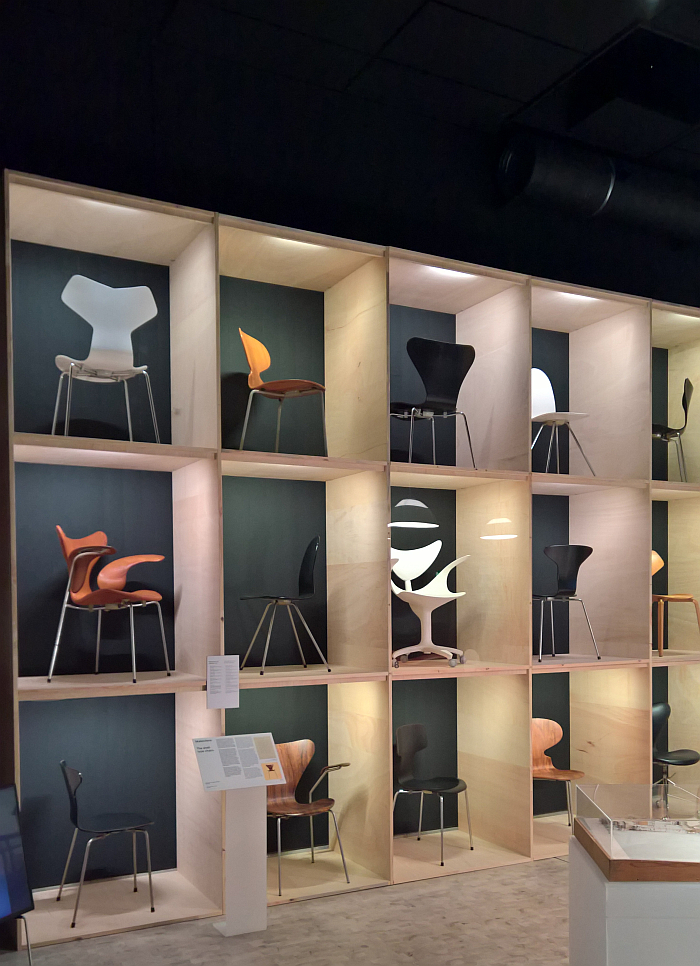
A presentation of moulded plywood chairs by Arne Jacobsen, as seen at Arne Jacobsen – Designing Denmark, Trapholt, Kolding
As one progresses through Designing Denmark‘s opening chapter the materials and production processes employed in and for Jacobsen’s furniture slowly change, moving, and generalising dangerously, from craft to industrial and from solid wood to plywood; for all the chairs migrate ever more away from crafted solid wood to industrially moulded plywood, including a collection of 15 Grand Prix’s in a variety of woods, a collection created in ca. 1958 for the Royal Agricultural University’s Department of Forestry and which stand in Designing Denmark as a very pleasing material library. Certainly pleasing for foresters. And gardeners.
And a presentation of moulded plywood shells which reminds us all that with the Ant Arne Jacobsen, and Fritz Hansen, realised the first commercial single piece, 3D moulded, plywood seat shell. That whereas an Aalto or a Breuer were moulding plywood in the 1930s, that was 2D, if wavy and flowing. That whereas an Eames and a Saarinen did achieve single piece, 3D moulded, plywood shells in context of the MoMA New York’s 1940 Organic Design in Home Furnishings competition, they remained experimental and would later be realised in alternative materials. That the 1940s plywood chairs of an Eames or an Eiermann feature a separate seat and backrest. The first single piece, 3D moulded, plywood seat shell, and thus an important moment in the (hi)story of furniture design was the otherwise unassuming Ant.
And a presentation of moulded plywood shells which tends to imply that whereas for an Eames or an Eiermann moulded plywood was a means to an end, was a material and a process to enable industrial production of furniture, for an Arne Jacobsen moulded plywood was a new freedom. And was a material and freedom to be tested and exploited in ever new formal expressions, in both new formal decorative and new formal functional expressions: “can something like that be made?”, Jacobsen is quoted in the Designing Denmark catalogue2 as often asking his engineers. And would then begin to experiment his way towards “that”. Sometimes he got there. Sometimes he didn’t. But he explored, experimented, challenged, the possibility.
And was also a material and freedom to be tested, exploited and explored in new contexts, that the projects for which Jacobsen designed became not just his architectural commissions but the wider social, civil, economic realities. And thus an important moment in the (hi)story of Arne Jacobsen’s furniture design.
That although he remained until the end of his career an unyielding Gesamtkünstler, through his experimentations with moulded plywood, and arguably through the possibilities he discovered, understood, in the course of that experimentation, Jacobsen also began creating furniture for the anonymous masses, furniture for the needs and demands of contemporary Danish society rather than the needs and demands of the definable users of a specific building; an important evolution in his understandings, one that can be considered intimately linked with moulded plywood, and one that was to remain with him over the coming decades. And the Ant was the start, if it found its (very natural and authentic) initial use and context in Jacobsen’s canteen building for Novo pharmaceuticals.
And thus the moulded plywood shell chair, logically, marks the start of the popular Arne Jacobsen biography, marks the moment when anyone could own a Jacobsen design, when Jacobsen became as much part of domestic life in Denmark as he had been of civic, commercial and institutional life in the preceding two decades. If a popular Arne Jacobsen biography that is today understood less by his contribution to domestic life in Denmark as by his contribution to the skyline of downtown Copenhagen: The SAS Royal.
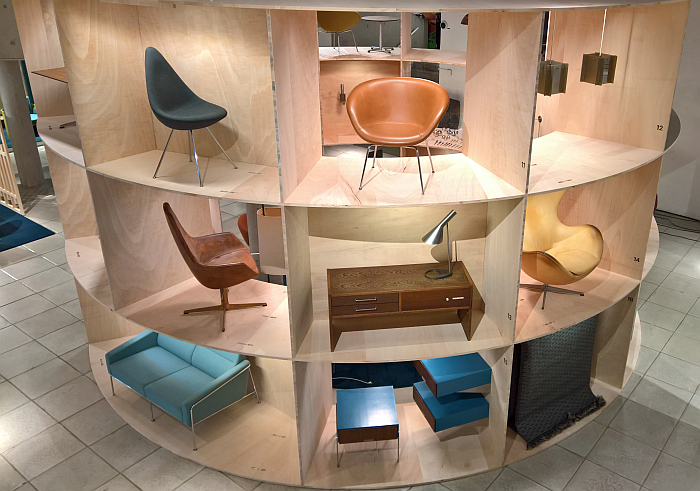
The SAS Royal Copenhagen, the round version, as seen at Arne Jacobsen – Designing Denmark, Trapholt, Kolding
A hotel, a Gesamtkunstwerk, a menagerie of Swans, Giraffes, Eggs, et al, that has not only been discussed on innumerable occasions in these dispatches, but has been, relatively, widely discussed elsewhere, and so a project we’ll skip quickly past. Save to note that there is something absolutely delicious about the way that most unyielding of quadratic works is presented and discussed in Designing Denmark in the round. Its cheeky, but respectful.
And to note that the SAS Royal is/was not only international in its expression but marks, in many regards, the start of Jacobsen’s international career, and that with him approaching his 60th birthday; and an international career which was largely realised following his untimely death on March 24th 1971 aged just 69. That whereas Jacobsen saw projects such the headquarters of the Hamburgische Electricitäts-Werke, HEW, in Hamburg or St Catherine’s College Oxford completed, projects such as, and amongst others, Mainz Rathaus or the Kuwait National Bank were began by Jacobsen but completed by Hans Dissing and Otto Weitling, two of Jacobsen’s long-standing partners and collaborators.
Designing Denmark ends with a chapter titled Arne’s Legacy, but which isn’t really, far more is a chapter concerned with the commercial administration of Jacobsen’s oeuvre and with contemporary editions of selected items of Jacobsen’s furniture and object design.
And which, yes, brings us to the Thonet Test, that question if an exhibition partner/sponsor is overly represented, overly present, in the content of the exhibition, if commerce dominates culture, if one finds oneself less in a museum and more in a museum shop; a test so-called because it almost only ever arises in context of Thonet exhibitions; and a test you know Designing Denmark passes: if it hadn’t you wouldn’t be reading this. And which it passes for all because after viewing everything that comes before the final chapter, and assuming you’ve been paying attention, which you have been, you understand that what is being presented in the final chapter isn’t Arne’s Legacy, understand it as a contemporary understanding of Arne Jacobsen, understand it as how Arne Jacobsen is positioned in the contemporary furniture and object design industries rather than Arne Jacobsen’s position in the contemporary furniture and object design industries. And there is a small but fundamental difference.
And also because you understand the final chapter is essentially all post-1950, that popularly understood component of the Arne Jacobsen biography; however, having viewed Designing Denmark you understand that before the 1950s Arne Jacobsen had enjoyed a long, varied and not unimportant career. And had, arguably, realised his more crucial projects and objects.
And thus you understand that Arne’s Legacy is to be found elsewhere. And in nothing tangible. Far less something you can stamp a trade mark on. And therefore are able to view, assess and enjoy the final chapter in context.
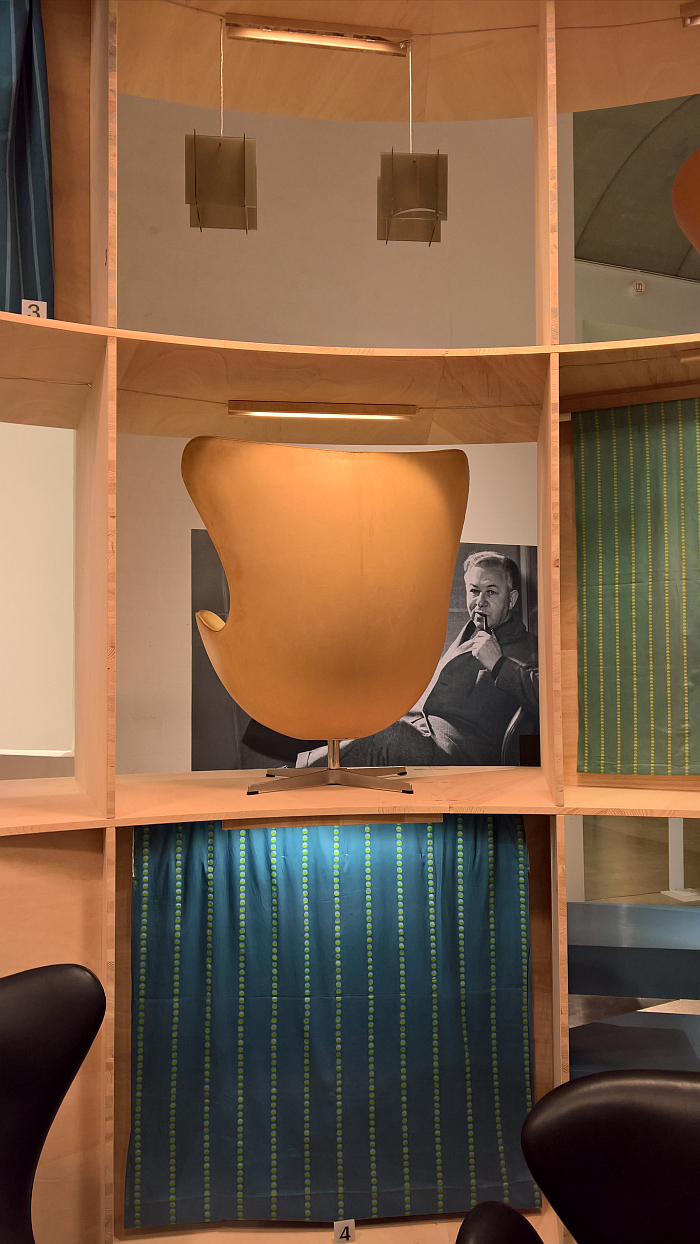
Arne considering if it is an Egg. Or maybe an inflated 3107? Or a developing bud, a yet unfurled leave, a seed…..?
Presenting some 400+ objects over some 900 square metres, the focus of Arne Jacobsen – Designing Denmark is, as the title implies, Jacobsen’s design, however the contexts in which that design arose is presented to a degree that allows one to not only understand the nature of the individual projects, but how they, individually and collectively, fit into the wider Jacobsen oeuvre and biography. The presented works being ably supported by concise, comprehensible, bilingual Danish/English texts and also numerous videos, in many of which, and very pleasingly, Arne Jacobsen himself comes to word. Designers rarely speak for themselves in exhibitions. Normally their work is left to speak for them.
Not that Jacobsen’s works are mute in the presence of their creator, far from it, and amongst the many works we enjoyed long discourses with, and in some cases still find ourselves in ongoing conversation with, one finds, and amongst many, many, others, a chair developed in 1927 as part of a collection of library furniture for the Fergo bookshop in Charlottenborg, and which is not only a formal delight, but in its mahogany reminds us that amongst the young Jacobsen’s teachers was Kaare Klint; a 1930s three legged swivel office chair developed with Fritz Hansen and which is not only one of the most satisfyingly reduced, yet impudent and spirited, examples of the genre we’ve seen, but underscores that the metal/wood chair combinations of the 1950s were nothing new for Arne Jacobsen; the folded plywood desks developed for Munkegård school, the most logical and intuitive of items, and objects which carry their rejection of a school as a place of tradition, ritual and hierarchical authority as a badge of honour; the book trolley for Rødovre library, a work which couldn’t be more anonymous but which perfectly underscores Jacobsen’s all-encompassing Gesamtkünstler approach; the 1968 Prepop chair for Askond, which all logic says should be in plastic, and which we genuinely spent 10 minutes believing was, and which thus helps focus considerations on Jacobsen and materials; the steel tube and leather upholstery 3400 chair from 1971 for and with Fritz Hansen which not only features curves and rolls that echo back to the 1920s, but helps underscore Jacobsen’s long relationship with Fritz Hansen, that the two cooperated for neigh on 40 years, and the importance of such relationships to the development of furniture, that furniture design isn’t about furniture designers alone.
We genuinely could go on, could mention the telephone table developed with Flemming Lassen for Søllerød town hall, the lamps for Aarhus town hall, the mobile record player for Rødovre library, the radio sideboard from the SAS Royal, a 1960s plywood barrel chair prototype, the telephone table developed with Flemming Lassen for Søllerød town hall…….
But we’ll stop.
And note that the number, and for all the variety, of engaging, communicative and articulate furniture and lighting designs presented in Designing Denmark helps underscore just what a small percentage of Jacobsen’s designs are popularly known today. And that the vast majority which are popularly unknown, are every bit as important as those that are popularly known. Not necessarily each and every piece individually, that would be exaggerating, but certainly collectively. And thus the utter fallacy of attempting to form an understanding of the designer Arne Jacobsen based on those designs that are popularly known. And certainly alone from those created after 1950.3
In addition Designing Denmark underscores the fallacy of attempting to form an understanding of the designer Arne Jacobsen based on his furniture and lighting designs alone.
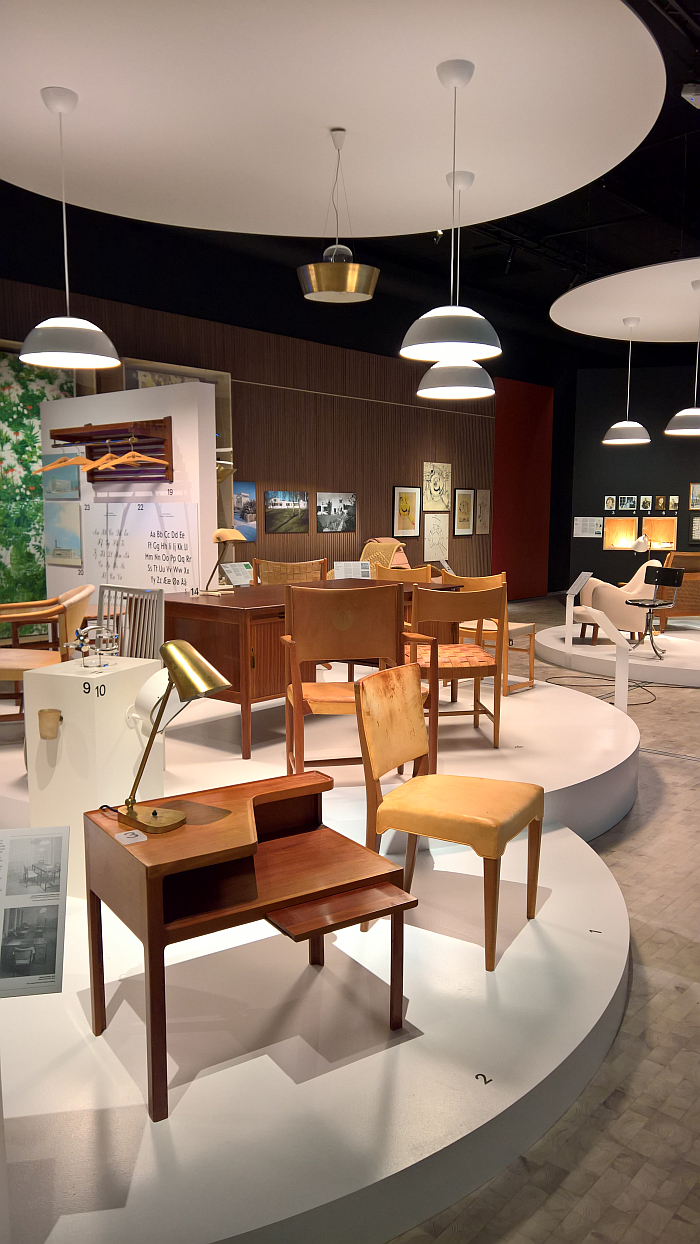
Telephone table developed by Arne Jacobsen with Flemming Lassen for Søllerød Town Hall, and a great deal more, as seen at Arne Jacobsen – Designing Denmark, Trapholt, Kolding
In the early 1940s Arne Jacobsen met his (future) second wife, Joanna Møller, a trained textile painter, and with whom, as Designing Denmark explains, he began transforming and reimagining his paintings as textiles and wallpaper, for all the those paintings featuring natural and floral motifs. In 1943 Jacobsen was, on account of his Jewish ancestry, forced to flee from the occupying, and increasingly aggressive, Nazis; Jacobsen and Møller crossing the Øresund to Sweden in a rowing boat with Inger and Poul Henningsen. An escape which, and not wishing in any way to detract from the seriousness and tragedy of the situation, has long sounded to us like a single-scene play waiting to written: Jacobsen and Henningsen in a rowing boat discussing the world both tangible and intangible, technical and social, as formed by nature and as formed by humans, PH with a cigarette, Arne with his pipe, perhaps all interspersed with a few songs by Poul Henningsen…….. But we digress…….
Safely arrived in Sweden Arne Jacobsen was in need of a source of work and income and found both in a cooperation with Stockholm’s Nordiska Kompaniet department store, an institution who not only sold but also produced furniture and accessories, and for whom Jacobsen and Møller realised a collection of textiles including, and amongst many others, works with evocative, romanticised?, names such as Summer Meadow, Wood Stumps or Clover. And a textile design career Jacobsen continued post-War in cooperation with Danish manufacturers such as Grautex and C. Olesen (Cotil), and that, as Designing Denmark discusses, in increasingly abstract expressions, if abstract expressions often based, however loosely, in nature, for all in plants; a canon of work fulsomely presented, discussed and explored in Designing Denmark; a canon of work which can be considered lost in the popular Jacobsen oeuvre; a canon of work we suspect will be re-issued with much fanfare before too long, possibly in Stockholm; but for all a moment in the Arne Jacobsen biography that allows for differentiated considerations on Jacobsen and his oeuvre, and for all the importance for that oeuvre of not just his art and artist’s view of the world, but of horticulture and his horticulturalist’s view of the world.
Hvis jeg får et nyt liv, vil jeg være gartner, didn’t arise from nowhere, certainly wasn’t an expression of a dissatisfaction with his then life, his career choice. But was based in a lifelong passion every bit as strong as that for painting, and in many regards in this life he was also a gardener: at home he kept a private specimen garden featuring plants collected on his travels, and whenever the opportunity arose, such as for example, at Munkegård School, St Catherine’s College or the Danish National Bank, Jacobsen designed gardens and green spaces for his projects.
And an affinity with plants, a passion for botany, and for all a keen observation of the plant kingdom undertaken through his painting and photography, and thus with the concentrated detail and focus such allows, that once understood allows for a fresh appraisal of his design work, allows one to approach an understanding of the curves, rolls and flowing organics of his designs, the regular formal references to the natural, for all the floral, world that can be found within his work, not necessarily always in the foreground but regularly there or thereabouts, as placing Arne Jacobsen’s design, and generalising to the point of inaccuracy, very much in the figurative florid tradition of Art Nouveau.
Arne Jacobsen an Art Nouveauist?
No. Although, there is an argument that could be made, for all in conjunction with his hang to the Gesamtkunstwerk. But much more a designer inspired and informed by the plantae. And whereas Art Nouveau’s florid fascinations were largely rooted, pun intended, in romanticism, in a search for a return to simpler times, Jacobsen’s florid fascinations are much more practical, objective, sachlich, are very much associated with a close study of the formal, the constructional, are, when one so will, syntactic rather than semantic, are based in structures rather than symbolism, in facts rather than idealisation, in the 20th century rather than the 19th century. And a passion for and detailed study of the floral which one could, can? argue caused Jacobsen to develop formal understandings with the natural world, for all the floral world, at its core. Albeit in a very reduced, rational, soberly distanced, expression.
And a core that Arne Jacobsen, and again one can only generalise in context of such a long and varied career, definites here are for the foolhardy, the disingenuous, but a core in the natural, the floral, that Jacobsen remained true to, if he continually evolved and developed as a designer in context of evolving social, cultural, technical, economic et al realities: his Art Déco of the 1920s and 30s is no different from his organic and Mid-century Modernism of the 1950s and 1960s, the core of Jacobsen’s understandings and positions didn’t change, the ways and means, the materials and processes, the contexts and interpretations, society and culture did: the Forest Snail is the Ant is the Swan is the Forest Snail, and all are the Egg, which sounds like Aesop, but isn’t a fable. And that through remaining true to himself, Arne Jacobsen developed a body of work where the form may be functional, but isn’t determined by it, the two exist independent of one another, if in close, and respectful, cooperation; a body of work which is able to communicate individually, attentively, responsively, with any give space, rather than one which brings fixed opinions with it and drowns out all other voices; a body of work cultivated rather than created, that developed into its final expression rather than being directed towards it, and which thus remains adaptable, malleable and primed to evolve further; and a body of work which despite an innate contemporary desire to pigeonhole it as some “-ism” or other, arguably exists free of such definitions. Exists alone in Arne Jacobsen’s understanding of, observation of, the natural, floral, world, and in Arne Jacobsen’s understanding of the Gesamtkunstwerk, whether in context of a specific building or wider society. Accepting the exceptions.
OK, that as may be, but er det dansk?, is it Danish design? You promised about a month ago to come back to the question, we’re waiting…….
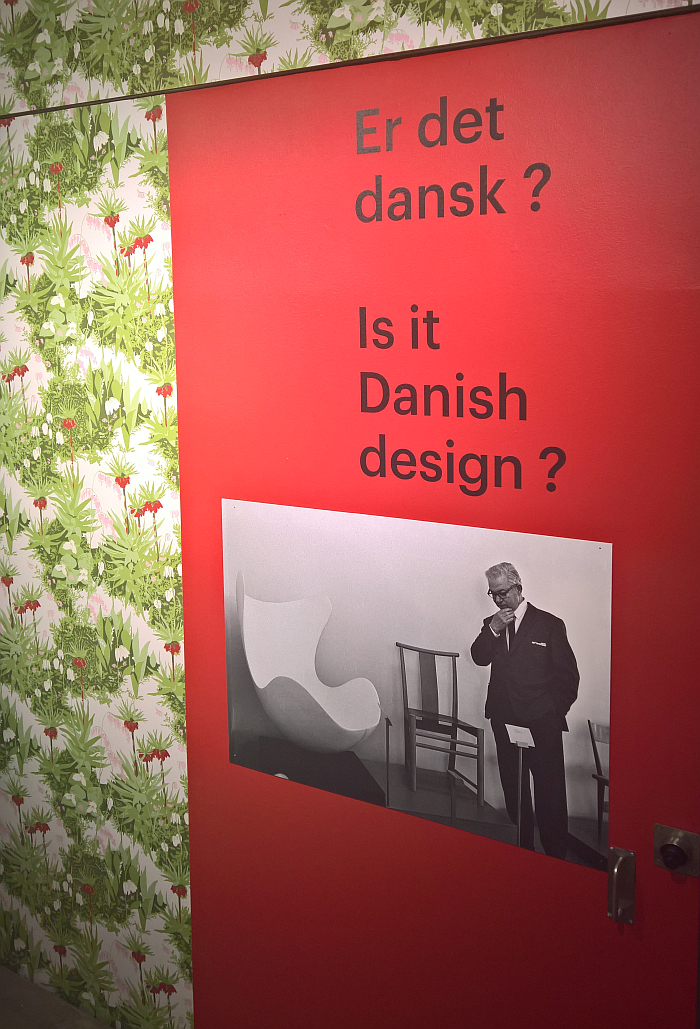
Arne looks uncertain…… The wallpaper is called Crown Imperial and is based on a painting by Arne Jacobsen, as seen at Arne Jacobsen – Designing Denmark, Trapholt, Kolding
And we will do, in a second post.
What!?!?!?!
Sorry!
On the one hand, with this post we’ve already dangerously distended the internet, and fear we’ll explode it if we continue, and on the other because it’s not really a question Designing Denmark can answer on its own. Even if we appreciate it is a central component of the curatorial concept. And a very valid component. But is a more fundamental question. Is a question that requires further reflection. Further input. That one first digest Designing Denmark.
Is however a question that should, must, accompany you throughout Designing Denmark.
And as an exhibition Designing Denmark gives you the space and time to do just that. Despite the scale and scope of the presentation, Designing Denmark is a very open, unhurried, easily accessible, and highly enjoyable and stimulating, tour through Arne Jacobsen’s life and design, a presentation that accompanies you as a friend rather than guides you as a teacher.
A presentation that in addition to furniture, lighting and textiles, and clocks, lots of clocks, clocks were obviously important to Arne Jacobsen, also features examples of silverware designed by Jacobsen for Stelton and numerous examples of Jacobsen’s artwork, including a painting of Le Corbusier’s Chapelle Notre-Dame du Haut which tends to imply that Jacobsen was less interested in the standardised, geometric Le Corbusier as in the more free-flowing, expressionist Le Corbusier. And thus reinforcing an understanding of a Jacobsen as a man, a designer, rooted, again intended, in the natural world. Of Jacobsen as a borderline Art Nouveauist.
And a presentation that in addition to encouraging you, insisting that you, ask er det dansk? for all encourages, demands, that you suspend all you thought you knew about the designer Arne Jacobsen, suspend popular contemporary understandings of the designer Arne Jacobsen, and start afresh.
Encourages, demands, that you consider the path Arne Jacobsen took from the 1920s to the 1970s in its full length, not the popular, abridged, version; consider the numerous, disparate, influences he was exposed to throughout those decades and how he responded to them; consider how he responded to the changing realities in Denmark; consider the relationships between his design and the changing realities in Denmark; consider the contexts in which his designs arose; consider the processes via which his designs arose; consider the influence on him of those he collaborated with; consider Jacobsen’s influence on those young designers such as Hans J Wegner or Verner Panton who worked for and with him; consider Arne Jacobsen’s 1920s and 30s work in context of Poul Henningsen’s 1920s and 30s work, were the always in the same boat?; consider his materials, his constructions, his compositions; consider Alvar Aalto; consider “can something like that be made?”; consider that in the 1990s Jacobsen was very much out in Denmark, his SAS Royal gutted, the furniture and furnishings thrown in skips, the Department of Forestry giving away, throwing out, his Grand Prix material library; consider that Jacobsen is now very much in, in Denmark and further afield; consider the disparity between the Jacobsen reception in the 1990s and in the 2020s; consider … no don’t consider that; consider Jacobsen the painter, Jacobsen the horticulturalist, Jacobsen the photographer; consider what you appreciate in the works of Arne Jacobsen, and why; consider which Jacobsen works you can’t engage with, and why; consider Arne Jacobsen’s position in the contemporary furniture and design industries; consider the Ox; consider what Instagram thinks about Arne Jacobsen; consider Arne Jacobsen from the 1920s to the 2020s, not the popular, abridged, version.
But for all consider where our furniture and object design would be today had Arne Jacobsen not waited until a next life to become a gardener.
For our part, we hope he got his wish, and if so are certain that he’s thoroughly enjoying himself. And smoking his pipe.
Arne Jacobsen – Designing Denmark runs at Trapholt, Æblehaven 23, 6000 Kolding until Monday May 24th
In addition at Trapholt one can visit the Jacobsen family’s former summerhouse, a construction realised in context of Arne Jacobsen’s 1969/1970 modular Kubeflex construction system.
Full details can be found at https://trapholt.dk
And as ever in these times, if you are planning visiting any exhibition please familiarise yourself in advance with the current ticketing, entry, safety, hygiene, cloakroom, etc rules and systems. And during your visit please stay safe, stay responsible, and above all, stay curious……..
- Arne Jacobsen – Designing Denmark, Trapholt, Kolding
- 2 Swans, the first to spot the difference wins bragging rights for the rest of the day….
- Grand Prix speaker by Arne Jacobsen for Munkegård school, as seen at Arne Jacobsen – Designing Denmark Trapholt, Kolding
- Series 7 by Arne Jacobsen through Fritz Hansen in a colour scheme by Tal R, as seen at Arne Jacobsen – Designing Denmark Trapholt, Kolding
- Objects, and typography, designed by arne Jacobsen for Søllerød town hall, as seen at Arne Jacobsen – Designing Denmark Trapholt, Kolding
- Recors player trolley and book trolley designed by Arne Jacobsen for Rødovre library
- Arne. Good at proportions, good at relationships, less good at scale as this early version of the Ant demonstrates, as seen at Arne Jacobsen – Designing Denmark, Trapholt, Kolding
- A 1960s formed plywood barrel chair prototype by Arne Jacobsen, as seen at Arne Jacobsen – Designing Denmark Trapholt, Kolding
- Looking accross a Munkegård school classroom, as seen at Arne Jacobsen – Designing Denmark Trapholt, Kolding
- 1920s and 1930s chair designs by Arne Jacobsen, as seen at Arne Jacobsen – Designing Denmark Trapholt, Kolding
- Paintings and textile designs by Arne Jacobsen, as seen at Arne Jacobsen – Designing Denmark Trapholt, Kolding
- Ant and Ant table by Arne Jacobsen, as seen at Arne Jacobsen – Designing Denmark Trapholt, Kolding
- Munkegård desk and chiar by Arne Jacobsen, as seen at Arne Jacobsen – Designing Denmark Trapholt, Kolding
- 3400 chair and tables by Arne Jacobsen for Fritz Hansen, as seen at Arne Jacobsen – Designing Denmark Trapholt, Kolding
- Crown Imperial and AJ wall lamps through Louis Poulsen, as seen at Arne Jacobsen – Designing Denmark Trapholt, Kolding
1. Lisbet Balslev Jørgensen quoted in Carsten Thau and Kjeld Vindum, Arne Jacobsen, Architektens Forlag, Copenhagen, 2002
2. Katrine Stenum Poulsen [Ed.], Arne Jacobsen – Designing Denmark, Trapholt, Kolding, 2020
3. Before anyone accuses us of attempting to do just that in context of the Egg, we didn’t!!! Considerations on Jacobsen came first, the Egg, however, neatly encapsulates many aspects of Jacobsen, and is an excellent conduit for further considerations on Jacobsen. But only in context of the full Jacobsen biography.
Tagged with: Arne Jacobsen, Designing Denmark, Kolding, Trapholt Museum
